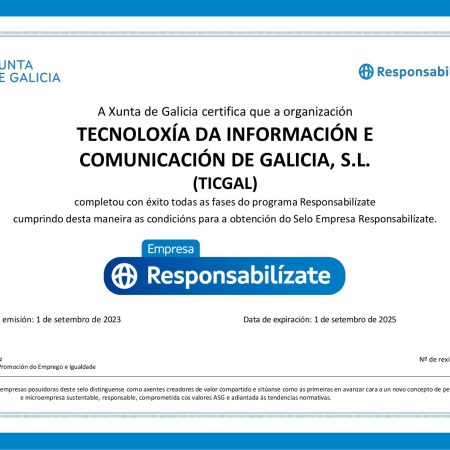Introducing the Signaturit – TICgal partnership
TICgal has been a Teclib’ partner for GLPI for more than 5 years, being the first in Spanish in the world. During these years, we have gone from implementing one of the best open source ITSM solutions in the market to contributing to its growth and popularization with the implementation of new installations, the development of plugins to cover additional needs of IT departments and even a mobile application.
The next logical step in our evolution was adding integrations. Fortunately, an interesting project was presented to us in the middle of the pandemic has resulted in a partnership between Signaturit and TICgal, which we are announcing publicly today.
El siguiente paso lógico en nuestra evolución eran las integraciones y un interesante proyecto que se nos presentó en plena pandemia ha derivado en la alianza entre Signaturit y TICgal, que hoy anunciamos públicamente.
No one is better than themselves to explain what they do. Our approach will be that of a case study.
Asset Handover: The solution to User Asset Management
What is GLPI
GLPI is an advanced Information Technology Service Management software that helps you plan and simply manage your IT department needs; it inventories your assets and associated administrative and financial information, tracks productivity and performance, and records the performance and costs of your IT department.
GLPI is the best choice of ITSM software that combines open source technologies with the latest market trends.
To name a few of its features:
- Request management
- Incidents
- Requests
- Change management
- Problem management
- Inventory
- Access Management
- Financial Management
- Capacity management
- Service Catalog Management
- Knowledge management
How to quickly achieve an optimal Asset Life Cycle Management
Although GLPI is a fabulous tool for your IT department, plugins allow you to make it even better and cover aspects that may not apply to all organizations but to yours.
For example, a new employee arrives in your organization. You have to give him technological assets to fulfil his job: A laptop, a smartphone (with its SIM and associated line), a backpack for transportation…
How do you currently manage this?
A spreadsheet to record it, a text document to print signed by the user, digitized and archive the original because this electronic copy is helpful as a reference, even if it lacks legal validity, and cannot be used in court.
Rings a bell? I’m pretty sure it does—both to you and another zillion of companies.
Consequently, if all your users are registered in GLPI and all the assets are also inventoried, the only thing we need is a tool that combines them and performs the requested actions in the most automated way possible:
- Managing the asset status
- Assigning the asset to that user
- Generating a document for both deliveries and return.
- Gathering all assets currently owned by each user.
- Creating two new historicals:
- Users assigned to an asset.
- Users who have had an asset.
- And leaving a record of which technician and when each of the steps has happened.
This is indeed what Asset Handover, the asset management plugin for GLPI developed by TICgal, does.
Apparently, we have it all figured out.
Well, not everything. The generated document still needs to be printed, signed, digitized and archived. And let’s face it, this is the trickiest part.
Obtaining legal validity with Signaturit
This is where Signaturit brights. We delegate the responsibility for the electronic signature to the savvy techs ins Signaturit, and we manage to close the cycle in an efficient and legally valid way. And yes, even to take it to court.
What is Signaturit

Signaturit is a legaltech company founded eight years ago in Barcelona, Catalonia (Spain), with 3000 customers in more than 40 countries, and is accredited as a Qualified Trust Service Provider (QTSP) offering electronic signature, certified electronic delivery and electronic identification solutions.
Among the services offered, our integration currently supports two types of signature:
- Simple electronic signature
- It is possible to prove that the customer agrees with the data contained in a document. Typically, it would be associated with a checkmark. Some of its characteristics:
- It is fast and straightforward.
- It does not allow the user to be identified.
- It is possible to prove that the customer agrees with the data contained in a document. Typically, it would be associated with a checkmark. Some of its characteristics:
- Advanced electronic signature
- It consists of a set of encrypted data (biometric, location, etc.) attached to the electronic document to identify the person who generates it. With the following advantages:
- Easy to use and implement
- Allows recognition of the signer’s identity (Identification).
- Linked to the data; therefore, it detects any possible subsequent modification (Integrity).
- Therefore admissible as evidence in case of litigation.
- It consists of a set of encrypted data (biometric, location, etc.) attached to the electronic document to identify the person who generates it. With the following advantages:
What advantages do we obtain with the integration of GLPI and Signaturit?
If we recall the proposed case, all the workflow fitted, but we still had to:
- Manage associated documentation before and after signature
- Change the status of the asset.
By integrating Signaturit, we achieve:
- Obtain signed or rejected documents and replace them with those initially generated.
- The automatic change of status of the assets depending on whether the generated document is signed or not.
- Linking the document to the process and the assets and actors involved.
Let’s finally look at the workflow:

We have also generated a practical widget for GLPI’s native dashboard, showing the status of the documents sent to Signaturit every month. If you have never worked with GLPI or at least not with its latest version, remember that these graphs are dynamic and that clicking on any value will filter elements. Yes, just like you would do with a pivot table, except that here you would be accessing the documents along with their metadata and not just a list of numbers. For example, not only do we know that six documents were signed in September. By clicking on the blue bar for September, we will see precisely the six completed documents.

The roadmap
We are currently working on two tracks to improve further and exploit the possibilities offered by this integration:
- Asset Handover: Covering more cases and situations in the delivery of assets. Here you have a lot to say by indicating your needs.
- Signaturit: Automate the generation of other relevant documents and send them for signature. For example, contracts, confidentiality agreements… you name it!
Lastly, there is one point that I do not want to leave out. In GLPI, we can create and inventory any asset. Now extrapolate what you have seen, and don’t limit yourself only to electronic devices. Think about PPE, Vehicles… your company’s needs and your imagination are the limits, and TICgal will align with you to meet your needs.













Leave a Reply